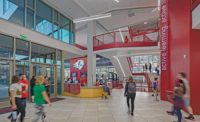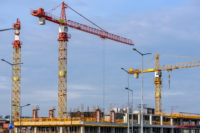Even though the �Great Recession� of 2008-09 is now behind us, McGraw-Hill Construction�s new report, �2010 Special Sector Study: Education Construction in Hard Times,� reveals that it will continue to haunt the halls of schools and colleges across the country for some time to come.
The construction of publicly-funded schools and colleges will continue to be weighed down by mushrooming state and local budget deficits, while the construction of privately-funded schools and colleges will suffer from a slump in alumni donations and the tumultuous movement of the stock market (where endowments are typically invested).
Exacerbating this situation, the ongoing crisis in capital markets has broken, or at least impaired, many of the funding mechanisms that have enabled construction to be undertaken.
However, aging school buildings across the country need to be upgraded or replaced, leading to pressure for growth in education construction. The expectations for the education market in the near-term, therefore, are mixed, with greater financial stability in the economy eventually resulting in growth, but that growth will be tempered by lingering impacts from the economic downturn.
Over the past three decades, the level of investment in U.S. education facilities has been impressive. From the low point of 74 million sq ft in 1981 to the most recent peak in 2001, education construction starts rose by 270% to an unprecedented 273 million sq ft. Following this peak, the economic recession in the early 2000s took a toll on education construction, and starts fell 23% over the next three years. Starts then turned the corner, rising to 223 million sq ft by 2008.
In 2009, however, the effects of the painful 2008-09 recession once again brought starts down�this time by 50 million sq ft to 173 million sq ft. This recession was so ruthless that it forced, in one year, a percentage decline (22%) very close to what had occurred over three years in the previous downturn. The 2009 level investment is nevertheless noteworthy, particularly since many types of commercial construction (notably stores, offices, and warehouses) reached historic lows during the year in response to the recession and financial crisis. These declines, in fact, made education construction the largest component of nonresidential construction in 2009�measured in both dollars and square footage.
This recession, unfortunately, has been more severe than most, and over the next few years, the financial difficulties currently looming over the nation�s state and local governments will be a large hurdle for education construction.
According to the National Conference of State Legislatures, the 50 states faced an aggregate budget deficit of $174.1 billion in FY2010. Because NCSL predicts that the cumulative budget gap from the start of the recession in FY2008 through FY2013 will surpass $531 billion, the states face a huge hurdle to meet their obligations over the next several years.
Consecutive cuts in state and local budgets will take their toll on the education sector. The Center on Budget and Policy Priorities recently provided a sobering look at the recession�s impact on the financial viability of the nation�s schools: over 30 states have made cuts to funding for public schools, and at least 41 have cut funds and/or increased tuition for state colleges and universities.
These figures, however, do not even tell the entire story. State spending fell sharply during and after the 2001 recession. Through 2008, aggregate state spending remained below the FY2001 level (even though some states may have regained or surpassed prior levels). For the majority of states, lower levels of spending for education and higher education remained in effect going into the recession, making recent cuts that much more difficult.
While supply issues will remain a critical concern over the near term, the demand for school construction will also become more pressing. According to the U.S. Department of Education, the average age of a public school building in 2005 was approximately 42 years old. The General Accounting Office (GAO) has determined that the serviceable lifespan of an education facility is approximately 42 years, beyond which it deteriorates and becomes functionally obsolete (although the history of maintenance and repair also plays an important role). What this means is that the typical school building in the U.S. is now too old to be fully functional�a situation that should dramatically increase the need for the alteration, renovation and replacement of school facilities in coming years.
Thus, as the economy is restored to more solid footing over the next few years and capital markets return to normal, the long-term need to build new facilities, expand existing ones and repair, remodel or replace aging buildings will become more urgent, and projects long delayed will begin to move ahead. At the same time, it is important to remember that all factors�demographic, economic, and financial�point to a slower rate of construction growth for the next five years.
Education construction faces a tough road ahead. Change is afoot both for the education system and for the construction industry itself, and these changes will have an impact on future education construction. Ongoing austerity will create a mandate to keep construction costs under control and ensure greater efficiency in the construction process. The increasing use of sustainable building products and methods of construction and the overall need to reduce the carbon footprint of new and existing buildings will add to the changes in education construction. Finally, state and regional differences in demographic trends, product usage and other key factors will have important implications for the distribution of future education construction activity.




Post a comment to this article
Report Abusive Comment